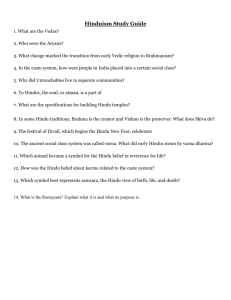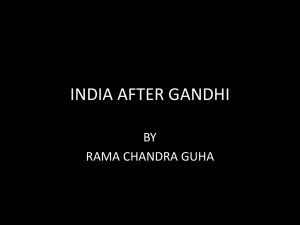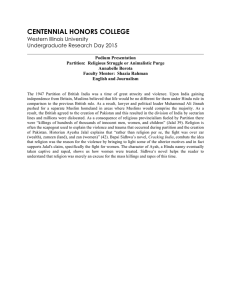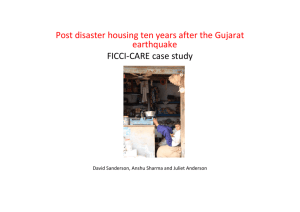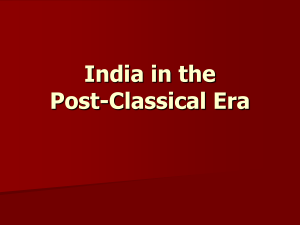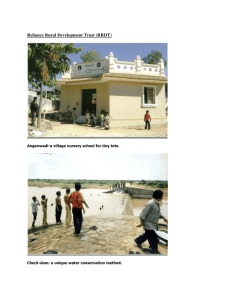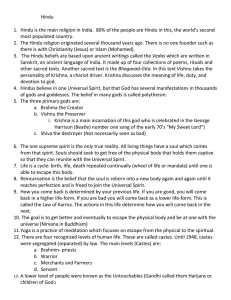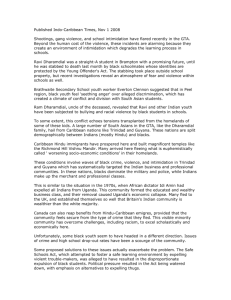Gujarat – Ahmedabad: a quagmire of recurring conflict
advertisement
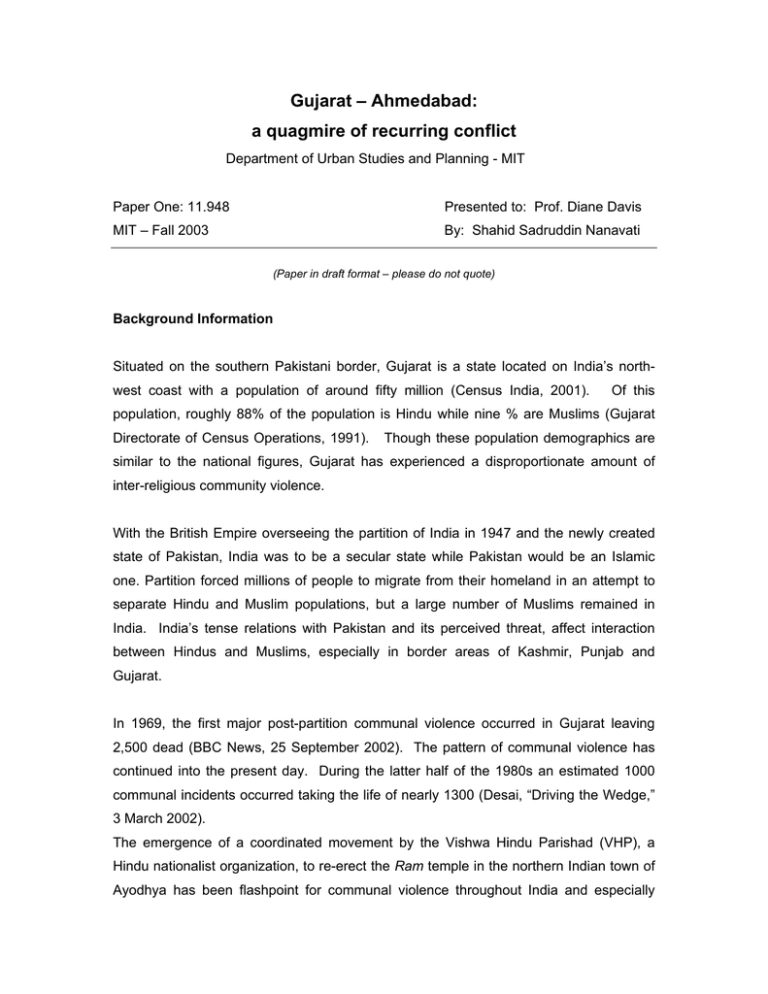
Gujarat – Ahmedabad: a quagmire of recurring conflict Department of Urban Studies and Planning - MIT Paper One: 11.948 Presented to: Prof. Diane Davis MIT – Fall 2003 By: Shahid Sadruddin Nanavati (Paper in draft format – please do not quote) Background Information Situated on the southern Pakistani border, Gujarat is a state located on India’s northwest coast with a population of around fifty million (Census India, 2001). Of this population, roughly 88% of the population is Hindu while nine % are Muslims (Gujarat Directorate of Census Operations, 1991). Though these population demographics are similar to the national figures, Gujarat has experienced a disproportionate amount of inter-religious community violence. With the British Empire overseeing the partition of India in 1947 and the newly created state of Pakistan, India was to be a secular state while Pakistan would be an Islamic one. Partition forced millions of people to migrate from their homeland in an attempt to separate Hindu and Muslim populations, but a large number of Muslims remained in India. India’s tense relations with Pakistan and its perceived threat, affect interaction between Hindus and Muslims, especially in border areas of Kashmir, Punjab and Gujarat. In 1969, the first major post-partition communal violence occurred in Gujarat leaving 2,500 dead (BBC News, 25 September 2002). The pattern of communal violence has continued into the present day. During the latter half of the 1980s an estimated 1000 communal incidents occurred taking the life of nearly 1300 (Desai, “Driving the Wedge,” 3 March 2002). The emergence of a coordinated movement by the Vishwa Hindu Parishad (VHP), a Hindu nationalist organization, to re-erect the Ram temple in the northern Indian town of Ayodhya has been flashpoint for communal violence throughout India and especially Gujarat. The Babri mosque, built by Islamic conquerors during the sixteenth century, stood on the site of what many Hindus consider to be the sacred birthplace of the god Ram (legally contested). Riots erupted in 1992, after Hindu extremist groups razed the mosque leaving a reported 2000 Muslims dead nationwide (BBC News, “Timeline: Ayodhya,” 27 Feb 2002). In the beginning of 2002, the VHP declared that it would begin building a temple in Ayodhya on March 15, 2002 and hundreds of volunteers had begun to converge on the site and scared the Muslim population away from the region, later looted their homes and shops (BBC News, “Timeline: Ayodhya,” 27 Feb 2002). Current Predicament On February 27, 2002, Hindu nationalist volunteers en route to Ahmedabad, Gujarat from Ayodhya were involved in a series of altercations at successive train stops with Muslims communities. When the train arrived in the Muslim majority community of Godhra, the pattern of Hindu heckling and violent gesturing directed at Muslims continued. When Hindu train passengers refused to pay Muslim vendors for their services, stone throwing ensued between groups, and escalated into the eventual fire bombing of two train cars by a Muslim mob, killing 58 Hindus, most of whom were women and children (Human Rights Watch, “ We Have No Orders to Save You,” April 2002). After the Godhra incident, a huge communal backlash by Hindus occurred, immediately leaving hundreds of Muslims dead and thousands more internally displaced (Human Rights Watch, April 2002). The state and national government came under extreme scrutiny from domestic and international human rights organizations for their inaction in the face of communal violence. The National Human Rights Commission sent by New Delhi to report on the Gujarat tragedy noted that, “there was a comprehensive failure of the State to protect the Constitutional rights of the people of Gujarat, starting with the tragedy in Godhra on 27 February 2002 and continuing with the violence that ensued in the weeks that followed” (NHRC, Final Order on Gujarat, 31 May 2002). 2 Actors, Institutions and Issues Sangh Parivar: Sangh Parivar is the collective name used to represent a family of powerful Hindu nationalist organizations. The most influential groups in the Parivar are the Rashtriya Swyamsevak Sangh (RSS), Vishwa Hindu Parishad (VHP), the Bajrang Dal (a youth branch of the VHP), and the Bharatiya Janata Party (BJP). What binds these organizations is Hindutva (“Hinduness”), an ideology that stresses the cultural importance of Hindu civilization to India and the need for India to be a Hindu state. In a nation where the overwhelming majority of the population is Hindu, the Sangh Parivar urges Hindus to remember and revere their culture and history. Opposition political parties and human rights groups claim that Hindutva exacerbates communal violence among Hindus and minority groups. The Sangh Parivar has been at the forefront of the Ayodhya temple issue deeming its construction a matter of Hindu pride and necessity. Rising as an opposition to the long dominant Congress party, which was widely viewed as corrupt, Sangh Parivar has emerged as a leading national political and ideological coalition (Haniffa Aziz, 2003). By not recognizing the caste system as part of its ideology, it discards an issue that has always divided Hindus (RSS.org, Organization, 9 November 2003). With Hindus of all socio-economic levels unified, it leaves members of other religious minorities in a particularly weak position. The Rashtriya Swayamsevak Sangh (RSS - “National Service Society”): The RSS is one of India’s most important social service organizations with an estimated 300,000 branches nationwide (Tamminen, Hindu Revivalism, 3 November 2003). As the one of the first major Hindu nationalist organizations, the RSS served as a patron for financial and electoral support base for the rest of the Sangh Parivar organizations. Formed in 1925, the main objective of the RSS is the formation of a Hindu state. The RSS felt that the independence movement failed to frame the nation around Hindu culture. Vishwa Hindu Parishad (VHP – “World Hindu Council”): The VHP is a populist Hindu organization that seeks to unite Hindus all over the world in order to protect the Hindu culture from outside influence and threats. Founded in 1964, The VHP works closely with the RSS. The main objectives of the VHP are to consolidate, strengthen, and make Hindu society “invincible” by protecting the human rights of the “national mainstream” from hostile outside forces. (VHP.org, Agenda and 3 Objectives, 3 November 2003) The VHP is a strong proponent of a Hindu state, as opposed to the current secular Indian state. The VHP speaks of Hindus as the oppressed nation surrounded by foreign invaders, particularly Muslim, who threaten Hindu civilization. The VHP is known for provoking religious tensions and violence, and in 1992, its supporters led the successful campaign to destroy the Babri mosque in Ayodhya (BBC News, “Timeline: Ayodhya Crisis,” 27 February 2002). Of Gujarat’s 18,000 villages, the VHP is known to have offices in 5000 (VHP.org 3 November 2003). Many mob leaders involved in the February-March massacres were reported to be activists from the VHP and Bajrang Dal (VHP’s youth wing). First Information Reports (FIR) taken by the police condemned VHP officials of leading the riots against Muslims in Ahmedabad in post-Godhra backlash (BBC News, “Hindu hardliners,” 6 March 2002). After the Godhra train bombing the VHP called a bandh (a strike) the following day in order to protest the attack. During the strikes, VHP members disseminated pamphlets, wherein they called on Hindus to boycott Muslims socially and economically in order to drive Muslims from Gujarat (Gujarat Carnage 2002: A Report to the Nation, 10 April 2002). Organization leaders in Gujarat have admitted to compiling voter registration lists the morning of February 28 to provide rioters with detailed information on the whereabouts of Muslim homes and businesses (Gujarat Carnage 2002: A Report to the Nation, 10 April 2002). The VHP has also been known to arm its cadres with trishuls (3 knived septars/bayonets), which many witnesses report as one of the most prominent weapons during the deadly rioting (Gujarat Carnage 2002: A Report to the Nation, 10 April 2002). VHP president Ashok Singhal has called the post-Godhra events a “successful experiment” in raising the consciousness of Hindus nationwide and of “emptying” a whole area of Islam. (Indian Express, 3 September 2002) Statements like this illustrate a clearly anti-Muslim policy in VHP leadership. Bharatiya Janata Party (BJP- “Indian People’s Party”): The BJP represents the political wing of the Sangh Parivar. Its policy follows the Hindutva ideology of the Sangh Parivar. Currently, the BJP leads the coalition National Democratic Alliance that controls the Indian Parliament. In 1998, the BJP gained control of the National government ending the single party dominance of the Congress Party. Members of the RSS and VHP form a large lobbying network and voting base for the BJP, which must rely on the ballot, and therefore the RSS and VHP for its power. As the leader of the National Democratic 4 Alliance coalition government, the BJP has had to restrain the Hindutva agenda, which at times frustrates the VHP. In Gujarat, however, the BJP has been able to stick more closely to Hindutva by filling positions with VHP and RSS members or those sympathetic to the Sangh Parivar cause. An excellent example of this is Chief Minister Narendra Modi who became a prominent figure after the February riots. Modi claimed to have done his best to keep the violence under control, and was lauded by the VHP for the way he handled the Godhra aftermath (BBC News, Hindu hardliners, 6 March 2002). Narendra Modi began his career with the Sangh Parivar as a member of the RSS. In the mid-1980s RSS leadership dispatched Modi to join the BJP in Gujarat. When the BJP came to power in the late 1990s, Modi gained a prominent status within the Gujarati government. As the current Chief Minister of Gujarat, Modi has received much national and international criticism for his handling of the February-March riots. His and the BJP’s support of the post Godhra bandh gave the VHP total freedom of action throughout the state, which allowed mass mobilization of Hindu mobs (HRW, “We Have No Orders to Save You,” April 2002). He defended that all steps necessary to prevent violence were taken and that the Hindu backlash against Muslims was a reaction, in which “the people of Gujarat showed in incredible restraint under grave provocation” (HRW, “We Have No Orders to Save You,” April 2002). According to the NHRC, the BJP-led State government failed to protect its citizens during the February-March violence. After receiving such criticism at home and abroad for the post-Godhra violence, the National BJP has acted forcefully to prevent a largescale flare-up of violence. As the ruling party in the national government, they have the power to allocate the resources necessary to diffuse potential sparks among religious communities. Gujarati Hindus and Muslims: Similar to the population demographics of India as a whole, in Gujarat, Hindus comprise a majority, with Muslims accounting for less the ten % of the total population. As minority in a state where the Sangh Parivar dominates the government, the Muslim community lacks true representation in state apparatus. Although Muslims are not completely innocent of wrongdoing, they have suffered the majority of the abuse. Muslims suffered systematic attacks on their homes, businesses, and places of worship in the weeks following the Godhra incident. Unofficial estimates assert that at least 2,000 perished in the aftermath, most of whom where Muslim, and 5 that upwards of 100,000 Muslims were living in NGO-administered refugee camps (Testimony of Kamal Mitra Chenoy to USCIRF, 10 June 2002). Currently, in the town of Vadodara, Muslims and Hindus have marked their separate territories by flying flags above their neighbourhoods hoping to prevent violence and also to clearly establish safe-zones for their communities (Indian Express, 2 October 2002). Many Muslims from districts outside of Ahmedabad have feared returning to their homes after the brutal massacre that occurred in late February. Successive incidences of communal violence has led to a ghettoization of Muslim communities, who have left property alongside Hindus to seek safety in numbers (HRW, “We Have No Orders to Save You,” April 2002). Nested-ness and Scale Looking at the nested-ness, according to Ashutosh Varshney (Far Eastern Economic Review - Hong Kong: Mar 21, 2002. Vol. 165, Iss. 11; pg. 26) Hindu-Muslim riots in India are understood to have two causes: the underlying and the proximate. The underlying causes are linked partly to perceptions of history. Since the 1920s, Hindu nationaliststhose who believe that India is a Hindu nation have argued that Muslims are fundamentally disloyal to India. Some also believe that the so-called Muslim period of Indian history, stretching from the 8th century to the 18th century, was a period of Hindu humiliation, when Muslim rulers ruthlessly attacked the pillars of Hindu culture, especially its temples of worship. Finally, some Hindus also think that Muslims are essentially aggressive by nature, and a demonstration of superior brute strength is the only way to alter their behaviour. The biggest exponents of such views are the Hindunationalist ideologues, many of whom rule Gujarat. India’s relationship with Pakistan presents a complicating factor by exacerbating the difficulties the Indian Islamic community faces. The VHP and the rest of the Parivar often portray the Muslim violence against Hindus as Pakistani sponsored or terrorist while the Hindu violence against Muslims is portrayed as natural reaction to communal tensions. The anti-Pakistan rhetoric effectively causes Hindus to fear Muslims as terrorists or subversives. Both communities have been left to fear each other, helping to polarize the situation. 6 Looking at the Scale, one aspect of this communalism was the "two-nation theory," the conception that wherever large blocs of Muslims could be identified within the same region they constituted a national group independent of the Indian nation (Brandon Lindsey, Gujarat, India: Foreboding Specter of Genocide 2003). This was one of many factors tending towards the ultimate development of the atmosphere from which the Pakistan separation movement began. When finally the separation of India and Pakistan occurred, one finds regions varying all the way from one extreme to the other, i.e., from those in which every Hindu and every Muslim is in a state of extreme tension and fear with respect to the other group, to those at the other extreme (and far from the borders) where little change in Hindu-Muslim relations occurred. Important in the latter situation were two facts says Ashutosh Varshney (Far Eastern Economic Review - Hong Kong: Mar 21, 2002. Vol. 165, Iss. 11; pg. 28): (1) the Muslims were personally known and offered no threat; and (2) their economic services were needed. The economic life of the region depended upon the fact that the Muslims, like the rest, had fixed and necessary duties to perform. They contribute notably not only to the economic, but also to the literary, scientific, professional, and educational life of India. Now just how are these relations to be conceived? The first background factor is the original invasion of India by the Muslims, the voluntary or involuntary conversion of many Hindus to the Islamic faith, and the long military domination of large parts of India by Muslim rulers. At no time, however, did the Muslims live as aliens in the land, as the British did, separating themselves in language and culture from the Hindus. In fact, Muslim rulers learned a great deal and borrowed a great deal from the Hindus. Thus India's new communalism has arisen during a struggle to reconstruct India politically. The struggle is centrally concerned with the legitimacy of the state, the distribution of state resources, power in society, and justice (David Ludden, 1996). It involves ideological and organizational innovation, mass mobilization, reinterpretations of the national heritage, shifting loyalties, and competition for political gains and control. He furthers says: The struggle is thus actually many different kinds of struggles in localities, regions, and national politics; and it has a very dark side and is of a very large scale. 7 Ebbs and Tides of Violence in Gujarat The common thread linking various disturbances lies in the perception that communal identity is not "fixed" but is a political construction, and that collective violence is not the behaviour of a frenzied crowd acting out of centuries-old animosities, but a planned political act, a tool of political mobilization used to change popular perceptions of group identification (Patricia A. Gossman, 1999). Presenting it in two parts: ONE: With the role of narratives. Nationalism is about love of the nation, and this is often a self-sacrificing love, as Benedict Anderson (1983/ 1991, 141) insists. However, the dark underside of patriotic love is rooted in fear and hatred of the “other”, and this is often also expressed in sacrificial terms. Contrary to what Anderson seems to claim, Peter Van Deer Veer (1996) says – nationalism cannot be understood without these dark undercurrents, which are constantly repressed and represented as "anomalies." As we know, history is the grand narrative of any modern nation-state. Both in the colonizing and colonized regions of the world, it is a story of liberation from oppression. The dark stories of terror and bloodshed are only memorized to be interpreted as either necessary steps toward liberation or "incidents" that might as well be forgotten. Whereas the official history of Indian nationalism, as told in Indian education, is the progressive story of the liberation of the people from foreign domination, thus the narration of patriotic love. But there is also a subtext that tells the story of partition, of hatred and violence between Hindus and Muslims. The subtext is that of events, of incidents that are called "communal" in order not to let them disturb the text of the emergence of freedom, of a normal, liberated nation-state. They have to be given meaning by the narrative frame of the emergence of a liberal nation-state. It is not so much that their memory is totally obliterated, that they are repressed, but that they are memorized as fragments of a story of which the unitary, rational subject is the liberal nation-state (Amrita Basu, et.al. 1995). These memories come back with slight ignition of political and economic sparks. History shows that political motives are achieved through such tides of violence. Abhorrent narratives are formed by special groups who then implant such anomalies into the psyche of the masses and time and again refresh them to generate tension. 8 TWO: Through History – Why was communal violence needed by the state before partition and after partition? The British officials clearly state the reason why they needed it: “Divide and Rule”: Lt. Colonel Coke, Commandant of Moradabad wrote in 1822: "Our endeavour should be to uphold in full force the (for us fortunate) separation which exists between the different religions and races, not to endeavor to amalgamate them (Sucheta Mahajan 2000). Divide et Impera should be the principle of Indian government." He further said, "I can not close my eyes to the belief that this race (Mussalmans) is fundamentally hostile to us and therefore our true policy is to conciliate the Hindus." Lord Canning expressed the same view: "…As we must rule 150 million of people by a handful (more or less small) of Englishmen, let us do it in the manner best calculated to leave them divided (as in religion and national feeling they already are) and to inspire them with the greatest possible awe of our power and with the least possible suspicion of our motives." Sir Henry Cotton wrote (Problem of India, 1905) referring to the Partition of Bengal in 1905: "For the first time in history, religious feud was established between them (Hindus and Muslims) by the partition of province. For the first time, the principle was enunciated in official circles: Divide and rule. The Mohammedans were officially favoured in every possible way." Lord Minto wrote to Morley: "I think that caste and religious differences, certainly in respect to the two great groups of Mohammedans and Hindus, are showing signs of weakening, and that in the next generation there is a great prospect of the disappearance of the separation of castes and religions in deference to the calls of political aims." The present Indian State was established in 1858 and communal violence was an integral component of it (Sir Henry Cotton, 1905). Following this policy, the British institutionalized communal violence in a systematic and methodical manner by communal representations in institutions, education, 1909 Morley Minto Reform, Communal Suffrage and Communal representation in all organs of the state and administration to incite bestial hatred based on religion. They laid the foundation of communal and caste vote banks. Government of India act of 1935 and Partition were to further incite communal violence (J. Nehru, 1946). This divide and rule policy of the colonialists besides weakening the unity of anti colonial forces, also had another aim, that was diversion. While division of the people weakened their unity and movement against the British, diversion from their struggles to something 9 else by communal violence was also an integral part of this policy. Communal violence was organised by the British because it provided them a pretext to further suppress the people and declare that it was not the colonial rule that was the cause of the problems of the Indian people, but that religion was the problem, and blamed the victims and their religions for the situation created by the colonial rule, and said that it is the policy of the British to be fair and pursue a Secular policy to " do justice to all religious communities." Thus communal violence was institutionalized in the state structures, used to weaken the unity and resistance of the people and used as a pretext to further attack them and cause diversions. The British colonialists had already perfected this in Scotland, Ireland and Wales. They had used religion as an instrument to divide the people there and establish their domination. This communal nature of the institutions and state structure did not change with the transfer of power in 1947 and this transfer of power itself was done in the midst of a communal carnage. The ruling circles continued the same state and same policy, as it also suited them on both sides of the border. The Indian state as well as the Pakistani state continued the same institutions and policies, causing more divisions and violence amongst people on the basis of religion, language, caste, national background etc. In "Secular and Socialist India" from 1947 – 2002, innumerable episodes of communal violence have been staged, killing thousands of people. In the "Islamic Republic of Pakistan" too thousands of Bengalis, Sindhis, Balochis, Ahmadiyas, Shias and others have been slaughtered. The tide of hatred that was created by the colonial powers is maintained and used systematically and seasonally for political gains. The tide rises around election times and ebbs after the political mileage is taken from it. Why is communal violence being organized today by the ruling circles and their state? Whose interest does Divide and Rule policy serve today? Who are they trying to divide and what for? What is this diversion today for? These are some of the questions that will be addressed in the second paper. They will help us in understanding the ebbs and tides of violence with respect to the urban dimension of the city of Ahmedabad and other cities of Gujarat. 10 Bibliography: Ambedkar, B. R. What Congress & Gandhi Have Done to the Untouchables Bombay: Thacker & Co. 1925 Amnesty International,“India: Hate Speeches on the violence in Gujarat must be stopped” October 16, 2002, http://web.amnesty.org/ai.nsf/Index/ASA200192002?OpenDocument&of=COUNTRIES\INDIA) Anderson, Benedict. Imagined Communities: Reflections on the Origin and Spread of Nationalism. Revised Edition ed. London and New York: Verso, 1991. Banu, Zenab. Politics of Communalism: A Politico-Historical Analysis of Communal Riots in Post Independence India with Special Reference to the Gujarat – Rajasthan Riots. Bombay, India: Popular Prakashan, 1989. Basu Amrita, and Kohli Atul (Editors): Community Conflicts and the State in India Papers presented at a conference at Amherst College, Massachusetts in 1995. BBC News. “Analysis: Why is Gujarat so violent?” September 25, 2002. http://news.bbc.co.uk/2/hi/world/south_asia/1856049.stm. October 30, 2003. BBC News. “Gujarat’s Muslims live in terror.” May 9, 2002. http://news.bbc.co.uk/2/hi/world/south_asia/1977246.stm. October 30, 2003. BBC News. “Hindu hardliners led Gujarat attacks.” March 6, 2002. http://news.bbc.co.uk/2/hi/south_asia/1857414.stm. November 5, 2003. BBC News. “Indian Troops head off Gujarat Violence.” September 26, 2002. http://news.bbc.co.uk/2/hi/south_asia/2282400.stm. October 25, 2003. BBC News. “Timeline: Ayodhya Crisis.” February 27, 2002. http://news.bbc.co.uk/2/hi/world/south_asia/1844930.stm. October 30, 2003. BBC News. “UK censures Gujarat rulers.” April 25, 2002. http://news.bbc.co.uk/2/hi/south_asia/1951471.stm. November 3, 2003. Census of India 2001. “Provisional Population Totals: Gujarat.” http://www.censusindia.net/profiles/guj.html November 5, 2003. Chenoy, Dr. Kamal Mitra, Shukla, S.P., Subramanian, K.S., and Vanaik, Achin. “Gujarat Carnage 2002: A Report to the Nation.” April 10, 2002. http://www.mnet.fr/aiindex/GujCarnage.html. October 30, 2003. Cotton, Sir Henry, An Address on the Problem of India. London, Political Committee of the National Liberal Club. 1905, First Edition. David Ludden, Contesting the Nation: Religion, Community, and the Politics of Democracy in India, Penguin Book House,1996 Desai, Darshan. Indian Express. “Driving the Wedge.” March 3, 2002. Human Rights Watch. “We Have No Orders to Save You: State Participation and Complicity in Communal Violence in Gujarat.” April 2002. Vol. 14 http://www.hrw.org/reports/2002/india. October 30, 2003. Engineer, Asghar Ali. Communalism and communal violence in India: an analytical approach to HinduMuslim conflict. Delhi, India: Ajanta Publications; Ajanta Books International,1989. Gujarat Directorate of Census Operation 1999 http://www.censusindia.net/profiles/guj.html November 5, 2003. Haniffa, Aziz, India Abroad (Princeton Uni. Press) 2003 11 Human Rights Watch, “India: Keep Peace in Gujarat,” November 3, 2003 http://hrw.org/press/2002/09/gujarat0926.htm Indian Express. “Jafri blamed for his ‘murder.’” June 4, 2002. http://www.indianexpress.com/full_story.php?content_id=3790. Nov 1,2003. Indian Express. “Last lap: C in BJP campaign stands openly for communal.” December 10, 2002. http://www.indianexpress.com/full_story.php?content_id=14532. November 3, 2003. Indian Legal Eagle: The Ultimate Law Portal, “Indian Penal Code: Offences Against Public Tranquility,” http://www.indianlegaleagle.com/laws/criminal/ipc/faqans1.htm#Q11 Jain, Sharda. Politics of terrorism in India: the case of Punjab. N.Delhi, India: Deep & Deep Pub. 1995. Jawharlal Nehru, The Discovery of India, Oxford India Paper-back, 1946, Karan Vijay. War by stealth: terrorism in India. New Delhi, India: Viking, 1997 Lexis-Nexis Academic Universe. BBC Monitoring: Asia Pacific. “India: Curfew clamped in Gujarat following communal clashes; two dead.” July 20, 2002. Sucheta Mahajan: Independence and Partition: The Erosion of Colonial Power in India. N Delhi Press, 2000 Michel Chossudovsky, War and Globalisation, The Truth behind September 11, Global Outlook, 2002 National Human Rights Commission. “Final Order on Gujarat.” May 31, 2002. http://www.nhrc.nic.in/guj_finalorder.htm, October 30, 2003. People’s Union for Civil Liberties.“An Interim Report to the National Human Rights Comm.” March 21, 2002. http://www.pucl.org/reports/Topics/Religion-communalism/2002/gujarat-nhrc-submission.htm. Nov. 3, 2003 People’s Union for Civil Liberties. “Role of Newspapers in Gujarat Carnage: A brief Analysis.” April 5, 2002. http://www.pucl.org/reports/Topics/Religion-communalism/2002/gujarat-media.htm. November 3, 2003 Pro Quest: (MIT – e-journal) Ethnic News Watch. Bhatt, Sheela. “Hate and Despair: ‘It had to be done, it had to be done.’” India Abroad. May 17, 2002. Vol. XXXII. No. 33. pg. M2. Pro Quest: (MIT – e-journal) Ethnic News Watch. Bhatt, Sheela. “The Wages of Faith.” India Abroad. March 15, 2002. Vol. 32. No. 24. pg. 3. RSS.org. “Organization.” http://www.rss.org/organisation.htm November 9, 2003. Rediff.com. “The Gujarat Riots.” http://www.rediff.com/news/godhra.htm November 3, 2003 Tapio Tamminen, "Hindu Revivalism and the Hindutva Movement," http://www.abo.fi/comprel/temenos/temeno32/tamminen.htm. Novembr 3, 2003 Times of India. “Fernandes briefs PM on Gujarat.” March 3, 2002. http://timesofindia.indiatimes.com/cms.dll/xml/comp/articleshow?artid=2697284&sType=1 Nov. 3, 2003 United States Commission on International Religious Freedom. “Testimony of Kamal Mitra Chenoy.” June 10, 2002. http://www.uscirf.org/hearings/10Jun02/Chenoy.php3. November 3, 2003 Van Deer Veer Peter, Writing Violence, International Paperback, 1996 Vishva Hindu Parishad. “Aims and Objects of Vishva Hindu Parishad.” http://www.vhp.org/englishsite/b-objectives/aim_object.htm. November 3, 2003 12
